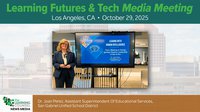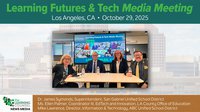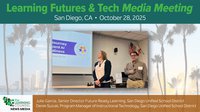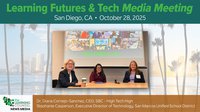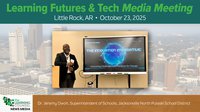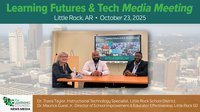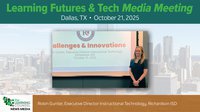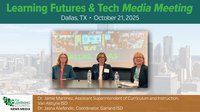Artificial intelligence is transforming learning from the elementary classroom to higher education. Some may see AI as an endeavor that will eventually supplant traditional learning, but in truth, AI has the potential to enhance learning by guiding students, opening doors of knowledge, and explaining concepts in detail. Properly integrated, AI facilitates personalized learning, enabling every student to achieve mastery at their own pace and build confidence in their knowledge.
However, the role of AI in education needs to be carefully curated, especially when it comes to younger students. The younger the child, the more important it is to make sure that AI is not used as a means to avoid original thought. Students in elementary school should have very limited, if any, exposure to AI-generated content, since their cognitive development relies so heavily on direct engagement in reading, writing, and problem-solving. In secondary school, AI should serve as a supporting tool and never replace critical thinking. Educators and parents need to be attentive to the use of AI, ensuring that the tool aids and does not interfere with intellectual development.
The Increasing Presence of AI in Classrooms
AI is already deeply ingrained in modern education. Children who don't have smartphones still experience AI-driven learning platforms, since most schools provide students with laptops or tablets that come pre-installed with AI-integrated software. Schools have been systemically changed by the adoption of technology, with modernization occurring for the sake of technology itself rather than any pedagogical enhancement. The tools enhanced by AI can be useful, but they need to be implemented in a manner that ensures they enhance and do not replace the human elements of learning.
Adaptive learning platforms, integrated into the classroom, automatically adjust instruction based on individual students' performance. These programs assess a student's strengths and weaknesses then make changes to lesson plans to allow students to continue at their own pace. AI-powered tutoring systems can also give immediate feedback and supplemental resources to support learning. While such development is very promising, the challenge still lies in how to make students more active participants rather than passive recipients of AI content.
Finally, whereas AI is integrating into education, there is also a budding concern over dependability on technology. It risks the capability for critical thinking and problem-solving among students on their own, due to the automation of some learning aspects, such as instant problem-solving and essay writing automation. That is why it is so important to establish clear boundaries on how AI should be used, especially in early education, so that it serves as a learning aid rather than a replacement for genuine intellectual effort.
AI and Multimodal Learning in 2025
The future of education lies in blending AI with multimodal learning experiences. Moving into 2025, several trends will shape how educators and students interact with AI-powered tools:
1. Rise of Immersive Multimodal Learning Experiences
Students' expectations are rising: interactive and engaging learning material, involving several senses. AI will be of key importance for the provision of short-form videos, curated by educators, along with interactive simulations and audio. This can help make learning more inclusive and effective by catering to different learning styles. It is believed that multimodal learning experiences can improve comprehension and retention by presenting information in varied forms such as visual, auditory, and kinesthetic approaches.
For example, AI can create interactive video lessons that answer student questions in real time for a far more dynamic learning experience. Simulations and game-like learning environments drop students right into the complexities of subjects like science and history, making the abstract concrete and far easier to understand.
2. More Intense Collaboration with the Teacher
Teachers will play an increasingly active role in developing and curating the content delivered with the use of AI, based on teacher judgment, and make sure the technology enhances the art of teaching and does not become a deterrent to it. AI should support teachers, enhancing their capacity to give personalized teaching rather than displace them.
The educational staff will require training on effectively integrating AI in teaching. The professional development training programs should make the teachers better understand the limits and capabilities of AI so it is used not to cut corners in lesson preparation or assessment, but to stimulate deeper engagement on the part of students.
3. Audio Models for Accessible Learning
Audio learning powered by AI will become an integral part of education, as students can now learn anywhere and at any time. This will be especially helpful for students who learn better through hearing or when multitasking is necessary.
With the increasing use of smart speakers and AI-powered voice assistants, students can now access on-demand explanations, language learning capabilities, and even audiobook-style course materials. This flexibility can be especially valuable for students with learning disabilities, providing alternative ways to engage with content.
4. Hybrid Learning Models Becoming the Norm
In the future, education will be balanced between in-person instruction and AI-enhanced, richly multimedia digital resources. In this blended model, it is recognized that although AI may improve learning efficiency, human interaction is not replaceable.
The flexibility of hybrid learning allows students to engage themselves in AI-driven lessons at their comfort while benefiting from the direct guidance and mentorship from teachers. Such a model could bridge the educational gap where students who need more time can have customized AI tutoring while bright students can move further ahead in more advanced topics.
5. AI-Powered Personalization Enhanced by Multimedia
AI will continue to develop the capability for offering customized learning experiences where the content would be changed dynamically in accord with the individual's preferences for learning styles-visual, auditory, or kinesthetic. Such personalization will make education both more appealing and effective.
AI learning that is personalized can ascertain how a student learns best and create lesson plans around that. For example, a student who struggles with reading comprehension but excels in visual learning may receive more infographic-based explanations, while another who learns best through discussion may engage with AI chatbots that simulate peer dialogue.
The Decline in Reading Rates: A Digital Age Dilemma
Despite being constantly connected to written content through smartphones, students nowadays read less than any generation that has ever existed. The prime suspect? Social media and a culture of instant gratification. Apps that give them quick dopamine hits have actually wired students to want brief and exciting content rather than the patience needed to sit down and read a book. Reading itself is actually an example of delayed gratification-something totally foreign in a world dominated by algorithm-driven entertainment.
Short-form content-from TikTok videos and Instagram reels to rapid-fire news snippets-has rewired students' attention spans, making it harder for them to engage in deep reading. The habit of skimming through social media feeds has created a sense of quick, digestible information, one that's usually at odds with the kind of focus longer texts require.
Advice You Can Give Parents
Parents can make all the difference in the reversal of the decline in reading rates. A few of the key strategies include:
● Role Modeling: Parents who read a lot are more likely to encourage their children to do the same.
● Reading to Younger Children: Reading to kids from an early age will help them develop an appreciation for books while strengthening familial bonds.
● Reducing the Use of Smartphones: Encouraging older kids to limit screen time and to focus more on reading can effectively alter their actions.
● Encourage Any Form of Reading: From novels to graphic novels to magazines, allowing the child to choose his or her own reading nurtures a loving relationship with the book.
● Reading is a fundamental skill that helps to build in a student the art of critical thinking, effective writing, and eloquent speaking. Inculcating good reading habits at a tender age will help students throughout their academic and professional lives.
Final Thoughts
AI is here to stay in education, and its integration into classrooms will only deepen in the coming years. But it needs to be carefully positioned so that it acts as a tool of learning, not a crutch that actually stifles critical thinking. This may mean positioning AI for personalization, multimodal learning, and accessibility, while holding firm on foundational skills of reading and independent problem-solving, so students are truly prepared to have an education for the future.
This is the kind of initiative it will take from educators, parents, and policymakers to make certain that AI enhances learning without diminishing other important skills to be developed in students. If done thoughtfully, AI can revolutionize education in an innovative, yet deeply humane way.
About the author
Nhon Ma is the CEO and Founder of Numerade. This article comes courtesy of our publishing partner Educate AI Magazine.



